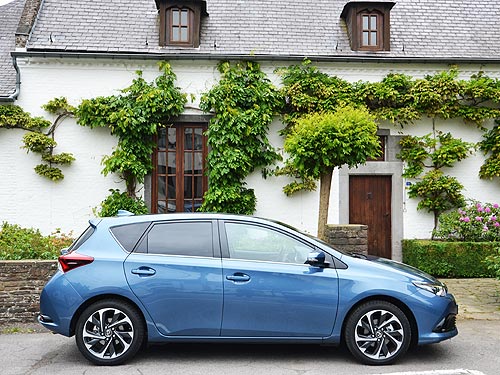
Auris with the flow
Before the automotive world is taken over by electric vehicles, we will probably pass the stage of hybrid cars. There are quite a lot of cars with such a drive, but so far they are mostly large cars, mainly because the hybrid drive is quite expensive. Toyota decided to cut costs by adapting the third generation Prius engine to the compact Auris. The HSD version has also recently appeared on our market.
The drive system used in the car combines a 1,8 VVTi internal combustion engine with a power of 99 hp. with an eighty-strong electric motor. In total, the car has a power of 136 hp. The Auris HSD is over 100kg heavier than the internal combustion version, but also slightly heavier than the Prius, which means its performance is a bit worse. Its maximum speed is 180 km / h, and the car reaches the first hundred in 11,4 seconds.
Inside the car, the biggest sign of change is a small joystick instead of a shift lever. Below it, there are three buttons that change the character of the car. The first one from the left excludes the internal combustion engine. The car then runs only on an electric motor, and its maximum speed is then limited to 50 km / h. However, the energy stored in the batteries is enough for a maximum of 2 km. When it ends, the internal combustion engine starts automatically.
Two consecutive buttons change the ratio between the electric support of the internal combustion engine and an increased level of energy saving and its recuperation during braking.
Another novelty is the dashboard. There is no tachometer on his left watch, but an indicator that informs about the operation of the hybrid system. Its field is divided into three main parts. The central one shows the level of energy consumption during normal driving. The pointer moves to the left when the electric motor is recovering energy while driving downhill or braking, and to the right when the combustion engine is helping it the most but consuming the most power.
In the center of the speedometer, located on the right side, there is a display where we can also observe the operation of the drive system. One of the shields depicts three symbols: a wheel, a battery, and an internal combustion engine. Arrows from engine to wheel and battery to wheel or vice versa indicate which engine is currently running and whether the electric motor is driving the wheels or charging the batteries.
Like the Prius Hybrid, the Auris is powered by an electric motor. After pressing the Start button, the inscription Ready appears on the dashboard, which is ready and that's it - no vibrations from a running engine, no exhaust gases, no noise. After pressing the accelerator pedal, the car begins to roll smoothly, and only after a while the internal combustion engine starts. Auris HSD is quite a dynamic car, but accelerates quite softly and smoothly. In practice, the difference between Eco and Power modes seems small. In both cases, the car accelerated quite willingly and briskly. Basically the tooltip showing the operation of the hybrid system jumps faster from the eco area to the power area, I did not notice much difference while driving.
The advantage of starting on an electric motor is a more reasonable use of torque by this unit - I move a little uphill from home and sometimes even not very dynamic cars start to spin wheels in the snow. In the case of Auris HSD, this has never happened to me. On the other hand, I also failed to come close to the 4L/100km average claimed by Toyota, whether we're driving in built-up areas or on the road. I always have a liter more. Total, for a car of 136 hp. it's still very good. I think a Prius plug-in version would be more interesting. This will allow you to recharge the batteries and drive more distance on the motor itself. However, this will likely mean the need for larger batteries, so the Auris will lose even more luggage space. At the moment, this is the biggest loss compared to the combustion version.
Batteries occupied part of the trunk. Opening the hatch, we see the trunk floor at the level of the trunk threshold. Fortunately, that's not all - part of the space under it is occupied by three large compartments. After installing the batteries, 227 liters of luggage space remained, which is more than 100 liters less than in the case of the petrol version.
The hybrid technology in the Auris combines this type of drive with the functional interior of a compact hatchback that features an instrument panel with two large storage spaces and plenty of rear seat space. I was not convinced by either the functionality or the beauty of the lower, raised and massive part of the center console, in which the gear lever was placed. Under it there is a small shelf, but due to the thickness of the console, it is inaccessible for the driver, and there is no shelf on the console itself. Therefore, I did not have enough space for a phone or speakerphone.
I had a richer version of the car, equipped with dual-zone air conditioning and sat-nav, with seats partly upholstered in fabric and partly in leather. Several versions are offered. The cheapest has 6 airbags as standard, manual air conditioning, power windows and mirrors, a split and folding rear seat, and a 6-speaker radio.
Despite the price below the Prius Auris HSD is not cheap. the cheapest version costs PLN 89.
Pros
Dynamic driving
Low fuel consumption
Spacious building
Cons
High price
Small trunk